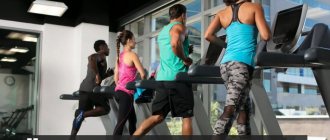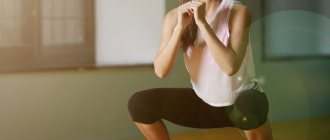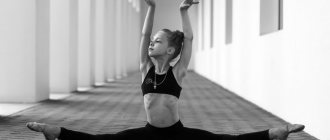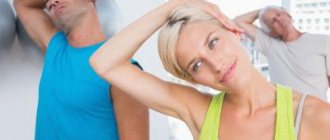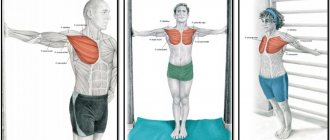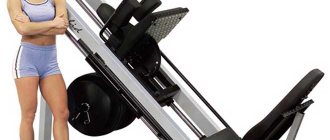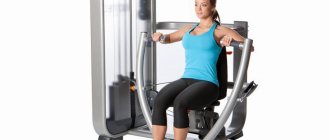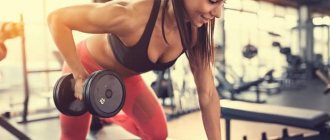Content
- 1 Soleus stretch
- 2 Achilles tendon stretch
- 3 Calf stretch
- 4 Tibialis anterior stretch
- 5 Stretching the everting ankle muscles
- 6 Inversion ankle muscle stretch
- 7 Stretching the foot pronators
- 8 Stretching the foot arches
- 9 Metatarsal arch stretch
- 10 Toe Extensor Stretch
- 11 Toe flexor stretch
- 12 Big toe adductor stretch
- 13 Spreading fingers
- 14
We stretch the biceps femoris (biceps muscle) and the back of the body.
Exercise 1. Lying on your back, pull your extended leg towards you.
We stretch the biceps muscle.
- Lying on your back, legs extended.
- Pull the straightened leg towards you. The toe is pulled out. We grab it in the thigh area or a little higher, in the shin area.
- To increase the stretch, you can raise your head and shoulders, thereby creating more tension in the biceps femoris muscle.
- You should feel a stretch in the back of your thigh.
- If you bend your foot (toe) towards you, you can additionally pull the calf muscle.
Exercise 2. Tilt with a straight body on an outstretched leg.
We stretch the biceps of the thigh.
We stretch the hamstrings, calf muscles, and Achilles.
- Stand up straight. Take half a step back with one foot.
- Begin to bend your back leg at the knee, squatting down slightly.
- The back is straight, hands on the belt. Squat on your back leg and lean your body forward to increase the stretch.
- The front leg should not leave the floor. The heel always touches the floor.
- You should feel a stretch in your hamstrings.
- To add a calf muscle stretch to the hamstring stretch, pull the toe toward you.
- You should feel a stretch in your hamstrings and calf muscles.
Exercise 3. Bending the legs at the hip joints.
Stretching the back of the body, hamstrings, and calf muscles.
This is one of the common stretching exercises. Muscles stretched: spinal muscles; posterior thigh muscle group; gluteus maximus, medius and minimus; hamstrings; piriformis muscle; adductor magnus; soleus muscle; calf muscle.
- Starting position: standing, feet shoulder-width apart.
- Relax, take a few breaths, close your eyes and feel the stretched muscles.
- We begin tilting the body slowly from the head, feeling how the cervical, thoracic, lumbar vertebrae bend and the muscles of the back and back of the body stretch.
- The arms are relaxed and relaxed, the body is relaxed.
- By clasping your legs with your hands, you can pull your body towards your legs and increase muscle stretching.
- We are in this position for 30-60 seconds.
- We also raise the body slowly. First the lumbar, then the thoracic and cervical vertebrae.
Barriers
Tightness of the posterior thigh muscles, back muscles and gluteal muscles. If the hamstrings are tight, slightly bending your knees will help relieve the stress on your spine.
We stretch the back surface of the legs: biceps, gastrocnemius, soleus muscles, popliteal ligaments.
This exercise is generally not recommended for middle-aged and elderly people with back problems. Theoretically, it can place unwanted stress on the discs and ligaments of the lower back, as well as the sciatic nerve. To reduce the risk of injury, perform with a straight back.
Exercise 4. “Slide” pose.
Stretch the back of the body.
- Get on all fours. Pull your pelvis up so that you get an angle of 90 degrees (or less).
- Feet and heels should not lift off the floor.
- Back straight, legs straight. You should end up with a pose similar to a triangle.
- You should feel a stretch in the back of the thigh, calf muscle, back muscles, and shoulder girdle.
Stretching the soleus muscle[edit | edit code]
Soleus stretch
What are you stretching?
: Muscles in the back of the foot (heel)
What are you abbreviating:
The front of the calves (dorsal ankle extensors, especially the tibialis anterior)
How many times to repeat:
10 per side
How long to hold:
2 seconds
Sit with the leg you are not using extended in front of you. Bend the other leg at the knee at an angle of 90°. Place your foot on the surface of the floor or table. Grasp the bottom of your foot with both hands and pull it towards your body as far as possible. At the end, help a little with your hands. If you cannot reach your foot with your hands, use a rope. Make a loop and place the foot you are working with in it, holding the ends of the rope with your hands.
One head it's good, but two better…
Assistant, sit next to the athlete. Let him do everything himself, but at the end help him a little. Grab your foot with both hands, your knee should be under your armpit. Pull slightly and hold for 2 seconds.
| Range | Position on the dial | Range of motion degree |
| Red range Too tight | 9.00-10.00 | 0-30 |
| Yellow range Normal | 10.00-11.00 | 30-60 |
| Green range Athlete's norm | 11.00-11.30 | 60”-75 |
| Blue range Hypermobility | 11.30-12.00 | 75-90° |
What are the benefits of leg stretching?
In addition to the main large muscles of the legs - the muscles of the thighs (quadriceps and biceps femoris) and calves, there are also less popular muscles among most beginner athletes (biceps femoris, semitendinosus, tibialis and others). In addition to the muscles, the legs also contain tendons and joints, which are also involved in the stretching process.
The benefits of doing leg stretching exercises are that it increases muscle endurance, flexibility, develops coordination, mobility and strengthens joints. It doesn’t matter where you do the exercises: in a sports club or at home, stretching the leg muscles significantly improves blood circulation, and the stretched part of the body gradually becomes elastic.
Of course, to achieve the maximum effect of toned legs, it is necessary to carry out strength training. Afterwards, the stretching process relaxes tense muscles, which promotes better oxygenation and more active recovery.
Achilles tendon stretch[edit | edit code]
Achilles Tendon Stretch
What you stretch:
“Chord” connecting the heel and calf (Achilles tendon)
What are you abbreviating:
Anterior calves (dorsal ankle-foot extensors, especially tibialis anterior)
How many times to repeat:
10 per side
How long to hold:
2 seconds
Sit with the leg you are not using extended in front of you. The second leg should be bent at the knee. The foot is on the surface, the heel is as close to the buttocks as possible. With both hands, grab the bottom of your foot. Lift it up, keeping your heel on the surface. Give a little help with your hands at the very end of this movement.
One head it's good, but two better…
Assistant, sit next to the athlete. Let him do everything himself, but help him a little at the end. Grasp the front of the foot of the leg you are working on with both hands and place your knee under your armpit. Pull slightly and hold for 2 seconds.
| Range | Position on the dial | Range of motion degree |
| Red range Too tight | 9.00-9.30 | 0°-15° |
| Yellow range Normal | 9.30-10.00 | 15°-30 |
| Green range Athlete's norm | 10.00-10.30 | 30°-45° |
| Blue range Hypermobility | 10.30-11.00 | 45-60° |
Benefits of Quadriceps Stretching
- In strength sports, stretching the hips is necessary for full muscle recovery after exercise. Overwork and shortening of the thigh muscles leads to a decrease in strength and a stop in progress.
- Allows you to develop longitudinal splits and perform most yoga asanas.
- The quadriceps, along with the buttocks, are stabilizers of the pelvis, so the tone and elasticity of these muscles also affect posture, supporting the lumbar spine in the correct position.
Calf muscle stretch[edit | edit code]
Calf stretch
What are you stretching:
Calf muscles (gastrocnemius)
What are you abbreviating:
Anterior calves (dorsal ankle-foot extensors, especially tibialis anterior)
How many times to repeat:
10 on each side
How long to hold:
2 seconds
Sit with both legs extended in front of you. To reduce stress on your back, you can bend the leg you won't be working on and place your foot on the surface you're sitting on. Loop the foot of the outstretched leg and grasp both ends of the rope with your hands. From your heel, bend your foot toward your ankle, pointing your toes toward your knee. Use a rope to help a little at the end of the movement. Remember that the leg should lie straight and the hip should not move. For an advanced stretch, you can lean forward at your hips and lean your body closer to your unbent knee.
One head it's good, but two better…
Assistant, let the athlete do everything using the rope, but at the end give him a little help. Grasp the top of the foot the athlete is working with both hands. Give it a little push and hold for 2 weeks. Once the joint is open, the athlete can lean forward toward the hips without bending the back to create a deeper stretch. Remind him not to bend his working leg at the knee.
| Range | Position on the dial | Range of motion degree |
| Red range Too tight | 12.00-1.00 | 0-30 |
| Yellow range Normal | 1.00-1.30 | 30°-45 |
| Green range Athlete's norm | 1.30-2.00 | 45°-60° |
| Blue range Hypermobility | 2.00-2.30 | 60-75° |
Stretching complexes
In martial arts, stretching training is divided into two main groups:
- Passive stretching , performed with relaxed muscles, and
- Active stretching , consisting of exercises that require muscle tension to perform.
Effective stretching training in martial arts is an alternation of tension and relaxation, but the result largely depends on how exactly the combination of tension and relaxation is selected, in what proportions, and in what sequence.
Good stretching in martial arts is not only about stretching the muscles, it is primarily about the ability to strike from positions that for a beginner may seem unstable and uncomfortable, but regular practice will allow almost anyone to improve the stretch and use it to strike.
Tibialis anterior stretch[edit | edit code]
Tibialis Anterior Stretch
What you stretch:
Anterior calves (dorsal ankle-foot extensors, especially tibialis anterior, and digital extensors)
What are you abbreviating:
Back of the calves (plantaris, soleus, gastrocnemius and finger flexors)
How many times to repeat:
10 per side
How long to hold:
2 seconds
Note
. You can use a folded towel, placing it on your thigh, under the ankle of the leg you are working on.
Sit with your legs extended forward on a flat surface. Lift the foot of the leg you will be working with and place it on the thigh of the other leg above the knee. Lean forward and grab the foot of the leg you will be working on from the side of your other leg. With your other hand, apply slight pressure to the knee of your first leg to stabilize it. Straighten the foot you are working with. You can help a little with your hand at the end of the stretch. To modify this stretch, pull slightly at the end of the exercise to stretch the tibialis posterior muscle.
One head it's good, but two better…
Note
. When you imagine a clock face, start with the foot of the leg you are working on perpendicular to the other leg. The clock is next to the foot, the fingers point to 12.00.
One head it's good, but two better…
Assistant, let the athlete do everything himself, but help him a little at the end. Use one hand to grab your shin to stabilize your leg, and the other to grab the top of your forefoot. Push a little and hold for 2 seconds. You can modify this exercise by turning your foot inward as you push.
Note
. 0° = 12.00
| Range | Position on the dial | Range of motion degree |
| Red range Too tight | 12.00-10.00 | 0°-60° |
| Yellow range Normal | 10.00-9.30 | 60-75° |
| Green range Athlete's norm | 9.30-9.00 | 75°-90° |
| Blue range Hypermobility | 9.00-8.30 | 90°-105° |
Exercises for the front of the thigh
In this section, we will look at the basic movements for stretching the front of the thigh (quadriceps).
Lying quadriceps stretch
- Lie face down on the mat.
- Raise your head, move your hand back and clasp your ankle with it.
- Pull your foot toward your buttock, while keeping your thigh pressed to the floor.
- Do the same with the other leg.
You can also use a rubber shock absorber or a jump rope here:
Mihai Blanaru - stock.adobe.com
Single Knee Quadriceps Stretch
- Get down on one knee, as if in a lunge.
- Place your hand on your front leg. With your other hand, grab the toe of your other foot and pull it towards your buttock. Try to tighten your gluteal muscles.
- Do the same with the other leg.
Kzenon - stock.adobe.com
Deep Lunge
- Take a deep lunge forward. The back leg should be straight.
- Lean your body forward and place your hands on the floor on either side of your front leg.
- The leg laid back is bent so as to reach the floor with the knee. Stretch forward, pushing your knee, you will feel the quadriceps of that leg stretch.
- Now repeat with the other leg.
Syda Productions - stock.adobe.com
Stretching the everting ankle muscles[edit | edit code]
Ankle Eversor Stretch
What you stretch:
Muscles of the outer side of the foot and calves (peroneus longus, peroneus brevis, peroneus triangularis, and extensor digitorum longus)
What are you abbreviating:
Inner foot and ankle (plantaris, soleus, gastrocnemius and toe flexors)
How many times to repeat:
10 per side
How long to hold:
2 seconds
Note
. You can use a folded towel, placing it on your thigh, under the ankle of the leg you are working on.
Sit with your legs extended forward on a flat surface. Lift the foot of the leg you will be working with and place it on the thigh of the other leg above the knee. Lean forward and grab the foot of the leg you will be working on from the side of your other leg. Lean forward and grab the foot of the leg you are working on on the other side with both hands. From the ankle side, rotate your foot inward, lifting your heel up. You can use your hand to help at the end of the stretch.
One head it's good, but two better…
Assistant, sit next to the athlete. Let him do all the work, but give him a little help at the end. Grasp the middle of your foot with both hands. Rotate your foot slightly inward and hold for two seconds.
| Left-hand side | Right side | ||||
| Range | Position on the dial | Range of motion degree | Range | Position on the dial | Range of motion degree |
| Red range Too tight | 9.00-9.30 | 0-15 | Red range Too tight | 3.00-2.30 | 0-5° |
| Yellow range Normal | 9.30-10.00 | 15°-30° | Yellow range Normal | 2.30-2.00 | 15°-30° |
| Green range Athlete's norm | 10.00-11.00 | 30-60° | Green range Athlete's norm | 2.00-1.00 | 30-60 |
| Blue range Hypermobility | 11.00-12.00 | 60°-90° | Blue range Hypermobility | 1.00-12.00 | 60-90° |
Stretching the inverting ankle muscles[edit | edit code]
Inverter Ankle Stretch
What do you stretch:
Ankle muscles (posterior and anterior tibialis)
What are you abbreviating:
Ankle (long and short fibular and fibular triangular, as well as long extensor digitorum)
How many times to repeat:
10 per side
How long to hold:
2 seconds
Sit on a chair or on the edge of a table. Lift the foot of the leg you will be working on and place it on the surface you are sitting on, in front of your buttock. Grab your foot with the hand on the side of your other leg. With your other hand, apply light pressure to the knee of your first leg to stabilize it. From the ankle, rotate your foot outward from the center of your body. You can help a little with your hand at the end of the exercise.
One head it's good, but two better…
Assistant, sit next to the athlete. Let him do all the work, but give him a little help at the end. Grasp the middle of your foot with both hands. Rotate your foot slightly outward and hold for two seconds.
| Left-hand side | Right side | ||||
| Range | Position on the dial | Range of motion degree | Range | Position on the dial | Range of motion degree |
| Red range Too tight | 3.00-2.50 | 0-5 | Red range Too tight | 9.00-9.10 | 0°-5° |
| Yellow range Normal | 2.50-2.40 | 5°-10° | Yellow range Normal | 9.10-9.20 | 5°-10° |
| Green range Athlete's norm | 2.40-2.30 | 10°-15° | Green range Athlete's norm | 9.20-9.30 | 10°-15° |
| Blue range Hypermobility | 2.30-2.00 | 15°-30° | Blue range Hypermobility | 9.30-10.00 | 15-30° |
Stretching the pronator muscles of the foot[edit | edit code]
Foot Pronator Stretch
What are you stretching:
Insertion of externally rotating foot muscles (peroneus longus, peroneus brevis, peroneus triangularis, and extensor digitorum longus)
What are you abbreviating:
Insertion of externally rotating foot muscles (plantaris, soleus, gastrocnemius, flexor digitorum longus, tibialis posterior and anterior, and flexor hallucis longus)
How many times to repeat:
10 per side
How long to hold:
2 seconds
Sit on a chair or on the edge of a table. The legs hang freely from the knee down. Raise the foot of the leg you will be working with onto the surface of a chair or table. Stabilize your position by grabbing your heel on the opposite side. With your other hand, grab your foot at the base of your toes. The hand touches the inside of the second leg. Rotate your foot inward and upward. At the end of the movement, help yourself a little with your hand.
One head it's good, but two better…
Assistant, sit next to the athlete. Let him do all the work, but give him a little help at the end. Hold your heel in one hand and hold your foot with your other hand. Rotate slightly inward and hold for 2 seconds.
| Right side | Left-hand side | ||||
| Range | Position on the dial | Range of motion degree | Range | Position on the dial | Range of motion degree |
| Red range Too tight | 3.00-2.50 | 0-5 | Red range Too tight | 9.00-9.10 | 0°-5° |
| Yellow range Normal | 2.50-2.40 | 5-10° | Yellow range Normal | 9.10-9.20 | 5-10° |
| Green range Athlete's norm | 2.40-2.30 | 10-15 | Green range Athlete's norm | 9.20-9.30 | 10-15° |
| Blue range Hypermobility | 2.30-2.20 | 15°-20 | Blue range Hypermobility | 9.30-9.40 | 15-20 |
Stretching the foot arches[edit | edit code]
Foot Arch Stretching
What are you stretching:
Insertion of externally rotating foot muscles (plantaris, soleus, gastrocnemius, flexor digitorum longus, tibialis posterior and anterior, and flexor hallucis longus)
What are you abbreviating:
Insertion of externally rotating foot muscles (peroneus longus, peroneus brevis, peroneus triangularis, and extensor digitorum longus)
How many times to repeat:
10 per side
How long to hold:
2 seconds
Sit on a chair or on the edge of a table. The legs hang freely from the knee down. Raise the foot of the leg you will be working with onto the surface of a chair or table. Stabilize your position by grabbing your heel on the opposite side. With your other hand, grab your foot at the base of your toes. The hand touches the outside of the first leg. Rotate your foot outward and upward. At the end of the movement, help yourself a little with your hand.
One head it's good, but two better…
Assistant, sit next to the athlete. Let him do all the work, but give him a little help at the end. Hold your heel in one hand and hold your foot with your other hand. Rotate slightly outward and hold for 2 seconds.
| Left-hand side | Right side | ||||
| Range | Position on the dial | Range of motion degree | Range | Position on the dial | Range of motion degree |
| Red range Too tight | 3.00-2.50 | 0°-5° | Red range Too tight | 9.00-9.10 | 0°-5° |
| Yellow range Normal | 2.50-2.40 | 5°-10° | Yellow range Fine | 9.10-9.20 | 5°-10° |
| Green range Athlete's norm | 2.40-2.30 | 10°-15° | Green range Athlete's norm | 9.20-9.30 | 10°-15° |
| Blue range Hypermobility | 2.30-2.20 | 15°-20 | Blue range Hypermobility | 9.30-9.40 | 15-20 |
Stretching the metatarsal arch[edit | edit code]
Metatarsal Arch Stretch
What are you stretching:
Muscles on the bottom of the foot, just behind the arch of the foot (transverse foot fibers)
What are you abbreviating:
Muscles that move the toes (including flexor digitorum longus, flexor digitorum brevis, and flexor pollicis longus)
How many times to repeat:
10 per side
How long to hold:
2 seconds
Sit with your legs extended in front of you. To relieve pressure on your back, you can relax the leg you won't be working on by bending it at the knee and placing the foot of that leg on the surface you are sitting on. Wrap the rope around the (extended) foot of your other leg, placing the loop just below the ball of your foot. Grasp the ends of the rope with your hands.
You can also do this stretch while sitting with your knee bent at a 90° angle. From your heel, walk your foot back toward your ankle, pointing your toes toward your knee. Hold this position with the help of a rope and “squeeze” your toes tightly. Keep your knee still and don't move your upper body. Grab your toes and press down slightly.
One head it's good, but two better…
Assistant, sit next to the athlete. Let him do all the work, but give him a little help at the end. Bend and stretch your toes (forward and back), hold for 2 seconds. You can work with each finger separately or all together.
| Range | Position on the dial | Range of motion degree |
| Red range Too tight | 12.00-12.30 | 0°-15° |
| Yellow range Normal | 12.30-12.40 | 15°-20° |
| Green range Athlete's norm | 12.40-1.00 | 20-30° |
| Blue range Hypermobility | 1.00-1.20 | 30-40° |
Stretching in Muay Thai
Muay Thai is a type of martial art in which kicking makes up the majority of the striking technique. Middle kicks, high kicks, and even knee strikes require a fitness component such as stretching or flexibility.
Flexibility is the ability of a joint to move freely and effortlessly along its amplitude (trajectory). Flexibility is a result of stretching and there are a number of factors that influence it. Flexibility depends on: - the innate anatomy of the joint, - the elasticity of the muscles and ligaments, - the state of the muscles - tone, - the general functional state of the body, - the surrounding training conditions. Flexibility is not a constant indicator and has its own stages, both physiologically (age-wise) and temporally: 1. Probably all athletes have noticed from their feelings how difficult it is to stretch in the morning. Indeed, in the early period of the day (6-7 am, depending on your regime), the flexibility of the body is reduced, but it is at this time that it is most effective. 2. Ambient temperature has a direct effect on flexibility. Cold reduces the ability to stretch, and heat promotes stretching. That is why before flexibility exercises, a good warm-up is necessary to warm up your body. 3. Fatigue and exhaustion negatively affect flexibility, but passive stretching with the help of a partner can improve the situation in this case. 4. The relationship between age and the tendency to stretch marks is familiar to everyone. At an early age, the body is more easily stretched due to soft and pliable tendons and ligaments, but if you do not stretch from the age of 7 to 13-14 years, then it is very difficult to regain good flexibility. At the same time, if you stretch regularly, you can still have flexible joints at 30-40 years of age. Speaking of stretching, it is difficult to ignore such an element that demonstrates flexibility as the splits.
Twine is an exercise in which the athlete spreads his legs, forming a straight line with them. There are two types of splits: - longitudinal - the legs are spread one forward, the other clearly back, the pelvis is turned towards the front leg, frontally. - transverse - legs spread apart. Doing the splits is difficult and takes time. If you are a mature athlete and want to get this result, then be prepared to spend about 1-2 months of intensive training to achieve good stretching and do the splits. Don't be fooled by offers of quick results. All sudden activities through pain and force can result in serious injuries. Stretching exercises should be carried out systematically, with good preparation and very smoothly. For example, now there are a lot of specialized classes aimed specifically at developing flexibility. And it should be noted that the lesson there is held according to the following system: 40 minutes - warming up and conditioning exercises and only 20 minutes - direct stretching. In addition to the fact that stretching in martial arts is necessary in order to deliver strong, technical and high blows, flexibility exercises have great benefits for the whole body:
— There is a decrease in muscle tension. — The range of mobility in the joints increases, which promotes healthy and correct body movements even in everyday life. — Coordination of movements improves. — There is an acceleration of blood circulation throughout the body. If necessary, blood flow to the necessary organs is improved. — The processes of energy production by the body are being improved. — The range of muscle work expands - muscle endurance increases. - Posture is corrected. Mental relaxation and relaxation occurs - In addition, in addition to the purely physiological effects, you, as a result, simply get pleasure and a feeling of lightness.
Factors influencing flexibility:
1. Age With age, due to various processes, the human body loses its elasticity. This physiological point should be taken into account in your training. The sooner you start working on flexibility, the easier and faster you will get results.
2. Gender A purely physiological feature, women are characterized by greater flexibility than men.
3. Exercise The obvious factor is that if you engage in physical activity, even without specific flexibility exercises, you are likely to be more flexible than those who play sports at all.
4. Temperature
This has already been discussed above. Body and environmental temperature affect our flexibility. Warmed muscle fibers are physically stretched more easily. A good visual example of the action of this factor is plasticine.
How to train to achieve results? The main aspects of the training process are: - intensity, - frequency, - duration, time, - type.
Frequency : Training volume per week
It is clear that there are no restrictions, and the more you do, the better. The minimum training should be 3-4 times a week, for example, after each Muay Thai class . Daily exercises will give maximum results.
Intensity : The "strength" with which you perform the stretch.
There's no point in trying. Perform the movements slowly and smoothly, increasing the pressure as you exhale. Breathe calmly, try to relax. Tune in to your sensations and don’t go beyond the feeling of “average discomfort.”
Duration : Time required to stretch
A session lasting 15-20 minutes is ideal. This is provided that you are already in a well-warmed state. It is advisable to perform each element in 2–3 approaches with a delay of 15–30 seconds.
Type : Stretching exercise set
Let's consider such types of exercises as: - static / dynamic stretching, - passive / active. Static stretching involves stretching muscles while remaining in one position. Most often, it looks like this: the athlete takes a special position that helps stretch a particular surface and, under the force of his own weight, gradually lowers down with little effort, makes a tilt or other movement depending on the initial position. Dynamic stretching is amplitude, but at the limit of possibility, movements (swings, bends, etc.), which contribute to the “lengthening” of muscle fibers. Usually these exercises are included in the warm-up.
Passive stretching expands the range of mobility using external resistance (partner, wall, floor). It is important during such exercises to ensure that your partner's pressure matches your abilities. If you feel pain, tell your friend about it and adjust his efforts. Active stretching is achieved by taking and holding certain positions without outside help, just by tensing your own muscles. An example of such a stretch is the leg-to-head exercise while lying on the floor. This stretching is not easy, it requires volitional efforts, and its elements are often found in yoga practices.
VIDEO 1
Stretching lesson for a fighter - why do you need splits for kicks? Andrey Basynin about stretching in martial arts
VIDEO 2
Stretching at home. How to do the splits quickly - Sergey Badyuk
Share
Toe extensor stretch[edit | edit code]
Toe Extensor Stretch
What you stretch:
Muscles on the top of the toes that help them bend upward (extensor toes longus and brevis)
What are you abbreviating:
Muscles on the bottom of the toes that help them bend down (flexor toes longus and brevis)
How many times to repeat:
10 per side
How long to hold:
2 seconds
Sit on a flat surface with your legs extended forward. Bend the leg you will be working with at the knee at an angle of 90°, and place your foot on the surface on which you are sitting. Grasp the bottom of the foot you are working with both hands. Keeping your heel flat, lift your foot and flex your toes. Use your hand to apply pressure on your fingers to help bend them more. A modification of this exercise can be to curl each finger separately.
One head it's good, but two better…
Assistant, sit next to the athlete. Let him do all the work, but give him a little help at the end. Help bend your fingers all together or one at a time and hold for 2 seconds.
| Range | Position on the dial | Range of motion degree |
| Red range Too tight | 12.00-12.30 | 0°-15° |
| Yellow range Normal | 12.30-1.00 | 15-30 |
| Green range Athlete's norm | 1.00-1.20 | 30°-40° |
| Blue range Hypermobility | 1.20-1.30 | 40-60° |
Toe flexor stretch[edit | edit code]
Toe Flexor Stretch
What you stretch:
Muscles on the bottom of the toes that help them bend down (flexor toes longus and brevis)
What are you abbreviating:
Muscles on the top of the toes that help them bend upward (extensor toes longus and brevis)
How many times to repeat:
10 on each side
How long to hold:
2 seconds
Sit on a flat surface with your legs extended forward. Bend the leg you will be working with at the knee at an angle of 90°, and place your foot on the surface on which you are sitting. Grasp the bottom of the foot you are working with both hands. Keeping your heel on the surface, lift your foot and forcefully open your toes so that they point in your direction. Use your hand to apply pressure on your fingers to help extend them further. A modification of this exercise can be to extend each finger separately.
One head it's good, but two better…
Assistant, sit next to the athlete. Let him do all the work, but give him a little help at the end. Help straighten your fingers all together or one at a time and hold for 2 seconds.
| Range | Position on the dial | Range of motion degree |
| Red range Too tight | 12.00-11.00 | 0-З0 |
| Yellow range Normal | 11.00-10.30 | 30°-45° |
| Green range Athlete's norm | 10.30-10.20 | 45°-55° |
| Blue range Hypermobility | 10.20-10.00 | 55°-60° |
Big toe adductor stretch[edit | edit code]
Big Toe Adductor Stretch
What you stretch:
Thumbs (adductor pollicis)
What are you abbreviating:
Thumbs (abductor pollicis)
How many times to repeat:
10 each finger
How long to hold:
2 seconds
Sit on a flat surface with your legs extended forward. Bend the leg you will be working with at the knee at an angle of 90°, and place your foot on the surface on which you are sitting. Grasp the bottom of the foot you are working with both hands. Keeping your heel flat, lift your foot slightly. Move your thumb away from the rest. At the end of the movement, help a little with your hand. (If your big toe is too weak to move, it will tilt inward. This condition is called hallux valgus. This can lead to bunions.)
One head it's good, but two better…
Assistant, sit next to the athlete. Let him do all the work, but give him a little help at the end. Grab your working foot with one hand, and with the other, move your big toe away from the rest, holding for 2 seconds.
How to properly stretch your leg muscles and do it as efficiently as possible and with less risk of injury?
- The first rule is not to overexert your body. It is important to allow the body to get used to the exercises gradually, and not immediately demand high results from it. Otherwise, it can lead to sprained leg ligaments and muscles. The rule also applies to those who already have experience in stretching if work resumes after a long break.
- Stretching exercises for the leg muscles must be alternated , and new techniques must be introduced each workout. Performing the same exercises over and over again leads to addiction and decreases effectiveness. And alternating exercises helps maintain tone and affects all muscles and tendons in turn.
- Stretching muscles always requires pre-warming up. This could be a pre-workout or even a 10-minute warm-up. Warm up before stretching here →
- Newcomers should start practicing stretching under the guidance of an experienced trainer in order to avoid injuries and sprains, which are easy to get even at home if the correct technique is not followed.
Once again about the importance of understanding sensations: do not overdo it, do not demand everything from your body at once.
Spreading fingers[edit | edit code]
Finger spread
What are you stretching:
Toes (deep transverse ligaments, long toe flexor ligaments, and toe extensor ligaments)
What are you abbreviating:
Toes (abductors and adductors)
How many times to repeat:
10 each finger
How long to hold:
2 seconds
Sit on a flat surface with your legs extended forward. Bend the leg you will be working with at the knee at an angle of 90°, and place your foot on the surface on which you are sitting. Keeping your heel flat, lift your foot slightly. Spread your fingers apart. At the end of the movement, help a little with your hand, spreading them wider in pairs.
One head it's good, but two better…
There are no specific degrees of range of motion for the toes. Typically you should be able to spread each pair of fingers 45° apart.
Assistant, sit next to the athlete. Let him do all the work, but give him a little help at the end. Spread your fingers in pairs, holding for 2 seconds.

